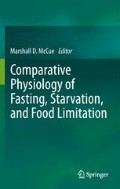Abstract
In the late nineteenth century, nutritional scientists and physicians recognized the clinical symptoms of human starvation, which they regarded primarily as a protein deficiency. In the absence of large studies of advanced starvation, they could not, however, determine how long a normal person could live without food. British physicians and famine relief officers feared the illusive “danger point” at which a starving person could presumably suffer a deadly collapse. Scientists made dramatic advances in their understanding of human nutrition in the first half of the twentieth century. They learned that the most critical factors in starvation were deficiencies in amino acids, vitamins, and, above all, carbohydrates. Yet these advances were slow to influence the treatment of starvation by British physicians. Prison medical officers, in particular, continued to focus on protein in their diagnosis and forcible feeding of the growing number of hunger strikers in British, Irish, and Indian prisons. Long after nutritional scientists had abandoned the Victorian maxim that protein was “the only true nutrient,” prison medical officers continued to forcibly feed hunger strikers a liquid mixture of milk, eggs, beef, and brandy.
Access this chapter
Tax calculation will be finalised at checkout
Purchases are for personal use only
References
Anderson WK (1994) James Connolly and the Irish left. Irish Academic Press, Dublin
Arnold D (1993) Colonizing the body. University of California Press, Berkeley
Benedict F (1907) The influence of inanition on metabolism. Carnegie Institution of Washington, Washington
Bombay Legislative Council (1932) Debates, 26 September 1932. Oriental and India Office Collection, British Library, L/PJ/7/423
Breen S (2004) Interview with Marian Price, 7 December 2004. http://irishfreedomcommittee.net/NEWS/december_2004.htm#MarianPriceinterviewDec04 (Accessed 12 September 2011)
Carpenter KJ (1994) Protein and energy: a study of changing ideas in nutrition. Cambridge University Press, Cambridge
Carpenter KJ (2003a) A short history of nutritional science: part 1 (1785–1885). J Nutr 133:638–645
Carpenter KJ (2003b) A short history of nutritional science: part 2 (1885–1912). J Nutr 133:975–984
Carpenter KJ (2006) Nutritional science in Victorian prisons. J Nutr 136:1–8
English R, O’Malley C (1991) Prisoners: the Civil War letters of Ernie O’Malley. Poolbeg, Swords, Co. Dublin
Governor of Mountjoy Prison (1919) Governor of Mountjoy Prison to the General Prisons Board, 6 November 1919. National archives of Ireland, GPB, Hunger Strikers 1919:7916–7990
Grant K (2006) The Transcolonial World of Hunger Strikes and Political Fasts, c. 1909–1935, In: Ghosh D, Kennedy D (Eds) Decentring Empire. Orient Longman, Hyderabad, pp 243–269
Grant K (2011) British suffragettes and the Russian method of hunger strike. Comp Stud in Soc and Hist 53(1):113–143
Hall-Matthews D (2008) Inaccurate conceptions: disputed measures of nutritional needs and Famine deaths in colonial India. Modern Asian Studies 42(6):1189–1212
Home Office (1909) Memorandum on Hunger Strikes, 12 October 1909. National Archives, Kew, HO144/1042/183256
Home Office (1914) Records on the hunger strikes of Harriet Kerr in 1913-14. National Archives, Kew, HO144/1275/239581
Home Office (1920) Memorandum by Griffiths GB, Senior Medical Officer, on Terence MacSwiney, 11 September 1920. National Archives, Kew, HO144/10308
Hutchison R (1911) Food and the principles of dietetics, 3rd edn. William Wood & Co., NewYork
Hutchison R (1948) Food and the principles of dietetics. Revised by Mottram VH, Graham G, Edward Arnold & Co., London
Kennedy B (1908) The hunger line. T. Werner Laurie, London
Keys A (1946) Human starvation and its consequences. J Am Diet Assoc 22:582–587
Keys A et al (1950) The biology of human starvation, 2 Vols. University of Minnesota Press, Minneapolis
Krausse AS (1886) Starving London. Remington & Co., London
Lusk G (1906) The elements of the science of nutrition. WB Saunders, Co, Philadelphia
Lusk G (1928) The elements of the science of nutrition. WB Saunders, Co, Philadelphia
MacEoin U (1980) Survivors. Argenta Publications, Dublin
McCue MD (2010) Starvation physiology: reviewing the different strategies that animals use to survive a common challenge. Comp Biochem Physiol 156A:1–18
Nash V (1900) The great famine and its causes. Longmans, Green, and Co., London
New York Times (1946) Irish hunger striker ends fast that began March 20. New York Times, 9 June 1946
New York Times (1968) To 40 Million children, CSM spells Life. New York Times, 5 Aug 1968
Northern Ireland Office (1972) Memorandum on escape of Robert Campbell, June 1972, National Archives, Kew, CJ4/850
O’Grada C (1999) Black’47 and beyond. Princeton University Press, Princeton
Pyarelal (2007) The epic fast. Navajivan Publishing House, Ahmedabad
Roose R (1890) Fasting and its physiology. New Review, May 1980, pp 409–417
Rosair HB (1936) Nineteen months’ hunger strike. Lancet 227:778–779
Scott JE (1904) In famine land. Harper & Brothers, New York
Simmons D (2008) Starvation science: from colonies to metropole, In: Nützenadel A, Trentmann F (eds) Food and globalization: consumption, markets and politics in the modern world. Berg, Oxford, pp 173–191
Vernon J (2007) Hunger: a modern history. Harvard University Press, Cambridge
Von Noorden C (1907) Metabolism and practical medicine. WT Keener & Co, Chicago
Author information
Authors and Affiliations
Corresponding author
Editor information
Editors and Affiliations
Rights and permissions
Copyright information
© 2012 Springer-Verlag Berlin Heidelberg
About this chapter
Cite this chapter
Grant, K. (2012). Fearing the Danger Point: The Study and Treatment of Human Starvation in the United Kingdom and India, c. 1880–1974. In: McCue, M. (eds) Comparative Physiology of Fasting, Starvation, and Food Limitation. Springer, Berlin, Heidelberg. https://doi.org/10.1007/978-3-642-29056-5_21
Download citation
DOI: https://doi.org/10.1007/978-3-642-29056-5_21
Published:
Publisher Name: Springer, Berlin, Heidelberg
Print ISBN: 978-3-642-29055-8
Online ISBN: 978-3-642-29056-5
eBook Packages: Biomedical and Life SciencesBiomedical and Life Sciences (R0)

